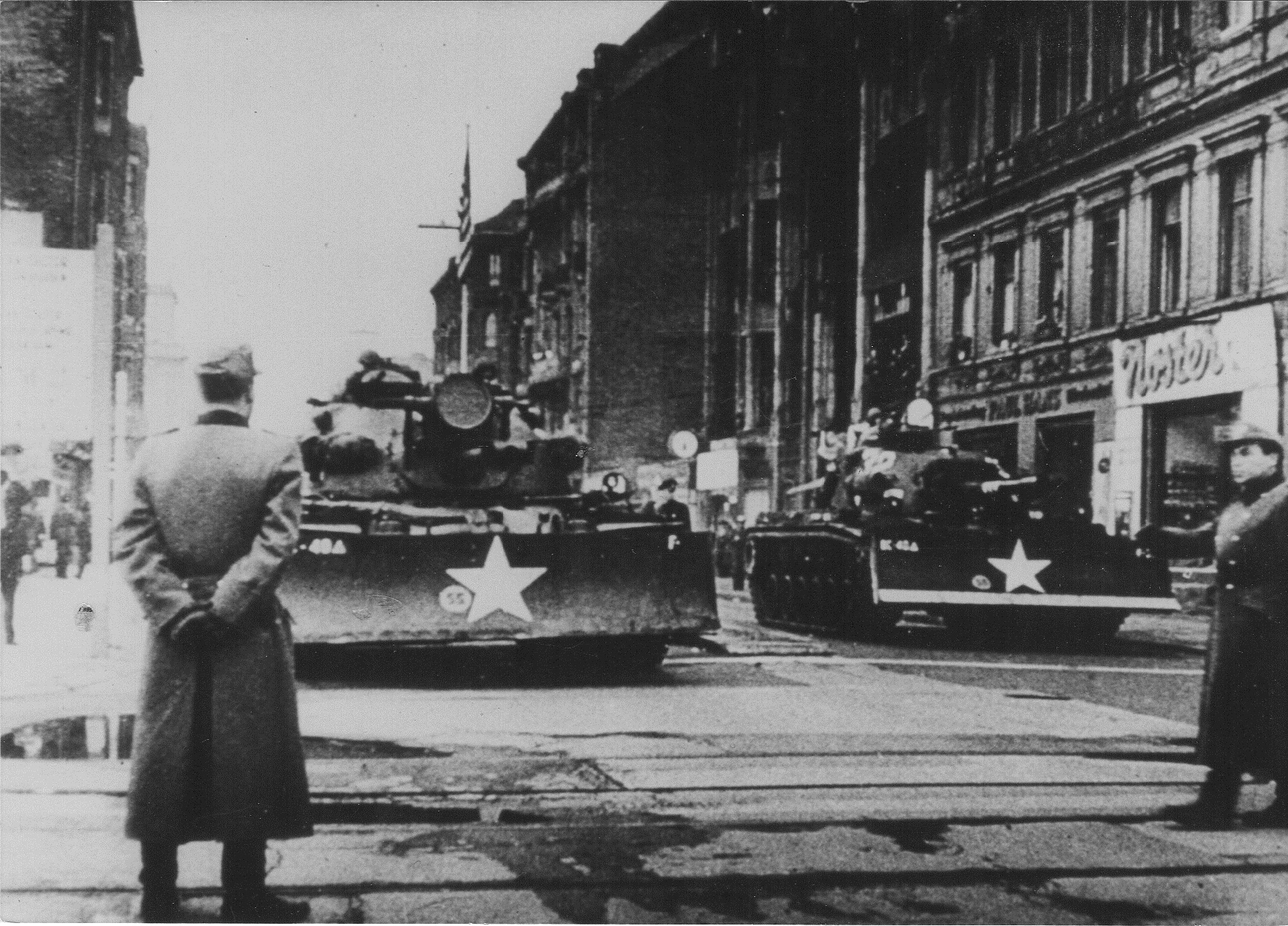Why the nuclear catastrophe failed to materialise
 Because of the Potsdam Conference, Berlin was divided into four sectors (Soviet Union, France, Great Britain and USA). Thus, as a result of political developments, such as the currency reforms and the different political systems, Berlin was divided into two sectors. Since 1949, Berlin has been divided into the Soviet East Zone, which was communist, and the capitalist West Zones of the Western powers (France, Great Britain and the USA). The Berlin crisis had its starting point as early as the late 1940s in the tensions between the East Zone and the Western powers, when the Soviet Union demanded that the Western powers leave Berlin in order to renounce any claim to West Berlin. This resulted in the Soviet military administration closing off all access routes to Berlin. The Soviet Union’s aim was to force the Western powers to surrender in this way through the so-called Berlin Blockade. But the Western powers refused to leave Berlin just like that. Finally, the USA relied on the airlift, so that Berlin was supplied from the air. The sultana bombers brought coal, food and other essentials to Berlin. Supplying Berlin from the air ensured that the Soviet Union no longer had any leverage to enforce its policies. The events thus confirmed the division of Germany into East and West Germany.
Because of the Potsdam Conference, Berlin was divided into four sectors (Soviet Union, France, Great Britain and USA). Thus, as a result of political developments, such as the currency reforms and the different political systems, Berlin was divided into two sectors. Since 1949, Berlin has been divided into the Soviet East Zone, which was communist, and the capitalist West Zones of the Western powers (France, Great Britain and the USA). The Berlin crisis had its starting point as early as the late 1940s in the tensions between the East Zone and the Western powers, when the Soviet Union demanded that the Western powers leave Berlin in order to renounce any claim to West Berlin. This resulted in the Soviet military administration closing off all access routes to Berlin. The Soviet Union’s aim was to force the Western powers to surrender in this way through the so-called Berlin Blockade. But the Western powers refused to leave Berlin just like that. Finally, the USA relied on the airlift, so that Berlin was supplied from the air. The sultana bombers brought coal, food and other essentials to Berlin. Supplying Berlin from the air ensured that the Soviet Union no longer had any leverage to enforce its policies. The events thus confirmed the division of Germany into East and West Germany.
Despite this first Berlin crisis, the Soviet Union repeatedly demanded the withdrawal of the Western powers from Berlin, which was to lead to a second and more profound Berlin crisis. The Khrushchev ultimatum of November 1958 was once again linked to the demand for the demilitarisation of Berlin. This demand was also aimed at Berlin being a free and independent city. According to the three-state theory, Berlin should become the third German state as an independent and free city alongside the GDR and FRG. Khrushchev’s demand could not be followed by the Western powers. Thus Berlin was seen as part of the Federal Republic of Germany and Berlin was therefore considered part of NATO. Furthermore, the transport routes to Berlin were not to be violated. Berlin also had rights of self-determination. For the USA in particular, giving in to the Khrushchev ultimatum would have meant a weakening of its prestige as a power of order in Europe. Nevertheless, a second Berlin blockade was in the offing.
As early as January 1959, the Soviet Union made a new offer: a peace treaty was to be concluded with the whole of Germany. The aim was that there should be a demilitarised and conducive Germany. The FRG rejected this offer. The other Western powers agreed to this offer. This led to another conference of foreign ministers in Geneva, where the Herter Plan (elections in Berlin before in all of Germany), and peace negotiations with all of Germany and the Berlin question were negotiated. So that it came to an inconclusive conference. Although the conference and a meeting between Eisenhower and Khrushchev helped to ease tensions, the situation was further aggravated when the Soviet Union shot down an American spy plane on its territory.
In 1961, after Kennedy took office, Germany policy changed and he announced the three essentials, according to which it was necessary to accept the presence of American troops in the city of Berlin, free access to the Federal Republic of Germany and the securing of the viability of the city of Berlin. With this, the USA succeeded in regaining the position of the doer. These three essentials were followed by the sealing off of Berlin, so that on 13 August 1961 the GDR erected the Berlin Wall. The Berlin Wall divided the city into two sections, which were now insurmountably dividing the city of Berlin. Accordingly, West Berlin was cut off from East Germany, but it was noted that the three essentials were respected despite the building of the Wall, as there was no expulsion of US troops, access to the Federal Republic at least by air, and the city was still viable. Thus the position of reunification on the part of the SU was now finally abandoned. Nevertheless, the Berlin Wall cemented the division of Germany into East and West Germany, so that the construction of the Wall was intended to prevent a vote with the feet. It also put a definitive end to the border crossing that had developed. Families in East and West Germany were thus torn apart.
The Berlin crisis shows how great the danger of war was. Clever tactics on both sides were able to prevent a major catastrophe. Nevertheless, the fact of Berlin’s occupation resulted in a continuing danger of a more far-reaching confrontation, which, however, was absent from every crisis. Thus, a decisive confrontation occurred when military and diplomats wanted to use Checkpoint Charlie. There, military personnel and diplomats could travel from West to East without being checked. Nevertheless, an example was made when American officers were to be checked in October 1961. A scuffle ensued, so that the Americans brought up tanks. The Soviet Union also moved in with tanks. Only a direct intervention by Khrushchev and Kennedy succeeded in having the tanks withdrawn. This avoided an escalation of the conflict. Nevertheless, Berlin remained an international flashpoint.
The Cuban Missile Crisis was also a direct consequence of the Berlin Crisis and shows how problematic the Berlin question had become. It was only with the construction of the Wall that the conflicts could be contained, although even in the year after the Wall was built, the Berlin question was still dicey.
In autumn 1962, the Cuban Missile Crisis finally broke out because the Soviet Union wanted to station nuclear weapons in Cuba. This was also about advancing the old demand for the demilitarisation of West Berlin. The Soviet Union hoped that this further stationing of nuclear weapons in Cuba would improve its own position in the negotiations on the status of Berlin. The USA intended to blockade the Soviet Union by sea, so that a naval blockade would make it impossible to deliver further nuclear weapons to Cuba. Khrushchev relented and withdrew his nuclear missiles from Cuba. In return, the USA assured that there would be no invasion of Cuba. The Cuban Missile Crisis, however, showed that the Berlin question offered tremendous explosive power. Nevertheless, the building of the Wall and the Cuban Missile Crisis showed that there should be no more crises over Berlin.


